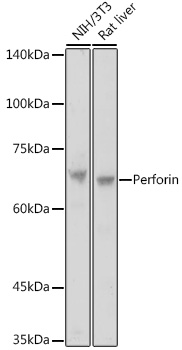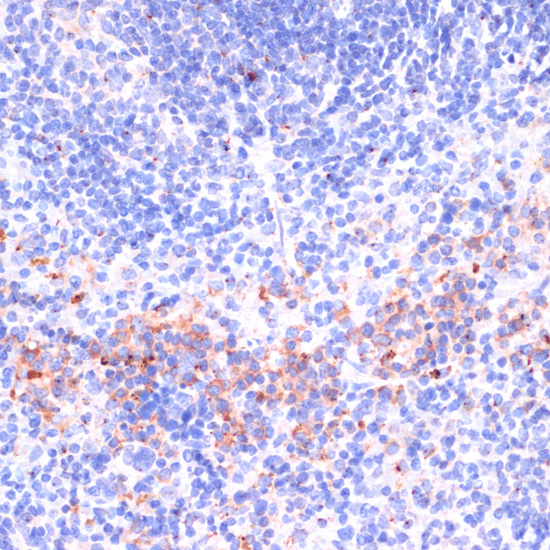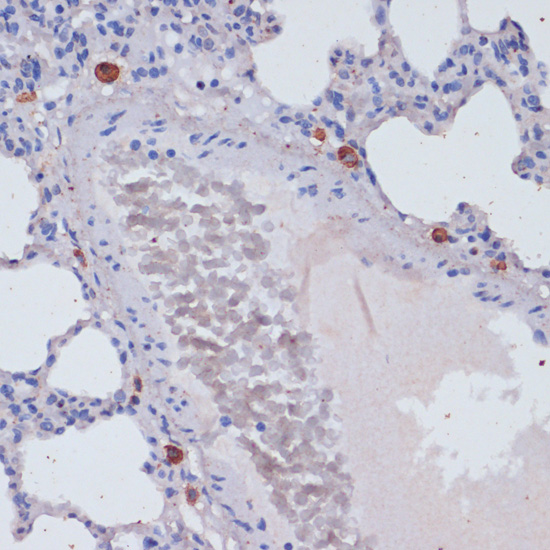Cell Biology Antibodies 1
Anti-Perforin Antibody (CAB0093)
- SKU:
- CAB0093
- Product Type:
- Antibody
- Reactivity:
- Human
- Reactivity:
- Mouse
- Reactivity:
- Rat
- Host Species:
- Rabbit
- Isotype:
- IgG
- Antibody Type:
- Polyclonal Antibody
- Research Area:
- Cell Biology
Description
| Antibody Name: | Anti-Perforin Antibody |
| Antibody SKU: | CAB0093 |
| Antibody Size: | 20uL, 50uL, 100uL |
| Application: | WB IHC IF |
| Reactivity: | Human, Mouse, Rat |
| Host Species: | Rabbit |
| Immunogen: | Recombinant fusion protein containing a sequence corresponding to amino acids 280-555 of human Perforin (NP_001076585.1). |
| Application: | WB IHC IF |
| Recommended Dilution: | WB 1:500 - 1:2000 IHC 1:50 - 1:200 IF 1:50 - 1:200 |
| Reactivity: | Human, Mouse, Rat |
| Positive Samples: | NIH/3T3, Rat liver |
| Immunogen: | Recombinant fusion protein containing a sequence corresponding to amino acids 280-555 of human Perforin (NP_001076585.1). |
| Purification Method: | Affinity purification |
| Storage Buffer: | Store at -20'C. Avoid freeze / thaw cycles. Buffer: PBS with 0.02% sodium azide, 50% glycerol, pH7.3. |
| Isotype: | IgG |
| Sequence: | EEKK KKHK MTAS FHQT YRER HSEV VGGH HTSI NDLL FGIQ AGPE QYSA WVNS LPGS PGLV DYTL EPLH VLLD SQDP RREA LRRA LSQY LTDR ARWR DCSR PCPP GRQK SPRD PCQC VCHG SAVT TQDC CPRQ RGLA QLEV TFIQ AWGL WGDW FTAT DAYV KLFF GGQE LRTS TVWD NNNP IWSV RLDF GDVL LATG GPLR LQVW DQDS GRDD DLLG TCDQ APKS GSHE VRCN LNHG HLKF RYHA RCLP HLGG GTCL DYVP QMLL GEPP GNRS GAVW |
| Gene ID: | 5551 |
| Uniprot: | P14222 |
| Cellular Location: | Cell membrane, Cytoplasmic granule lumen, Endosome lumen, Multi-pass membrane protein, Secreted |
| Calculated MW: | 61kDa |
| Observed MW: | 70KDa |
| Synonyms: | PRF1, FLH2, HPLH2, P1, PFN1, PFP, perforin-1, Perforin |
| Background: | The protein encoded by this gene has structural and functional similarities to complement component 9 (C9). Like C9, this protein creates transmembrane tubules and is capable of lysing non-specifically a variety of target cells. This protein is one of the main cytolytic proteins of cytolytic granules, and it is known to be a key effector molecule for T-cell- and natural killer-cell-mediated cytolysis. Defects in this gene cause familial hemophagocytic lymphohistiocytosis type 2 (HPLH2), a rare and lethal autosomal recessive disorder of early childhood. Alternative splicing results in multiple transcript variants encoding the same protein. |
| UniProt Protein Function: | PRF1: Plays a key role in secretory granule-dependent cell death, and in defense against virus-infected or neoplastic cells. Plays an important role in killing other cells that are recognized as non-self by the immune system, e.g. in transplant rejection or some forms of autoimmune disease. Can insert into the membrane of target cells in its calcium-bound form, oligomerize and form large pores. Promotes cytolysis and apoptosis of target cells by facilitating the uptake of cytotoxic granzymes. Monomer, as sobluble protein. Homooligomer. Oligomerization is required for pore formation. Repressed by contact with target cells. Belongs to the complement C6/C7/C8/C9 family. |
| UniProt Protein Details: | Protein type:Membrane protein, multi-pass Chromosomal Location of Human Ortholog: 10q22 Cellular Component: membrane; cytoplasmic membrane-bound vesicle; integral to membrane; extracellular region; plasma membrane Molecular Function:protein binding; calcium ion binding; wide pore channel activity Biological Process: formation of immunological synapse; apoptosis; cytolysis; defense response to tumor cell; cellular defense response; immune response to tumor cell; defense response to virus; transmembrane transport; protein homooligomerization Disease: Lymphoma, Non-hodgkin, Familial; Aplastic Anemia; Hemophagocytic Lymphohistiocytosis, Familial, 2 |
| NCBI Summary: | The protein encoded by this gene has structural and functional similarities to complement component 9 (C9). Like C9, this protein creates transmembrane tubules and is capable of lysing non-specifically a variety of target cells. This protein is one of the main cytolytic proteins of cytolytic granules, and it is known to be a key effector molecule for T-cell- and natural killer-cell-mediated cytolysis. Defects in this gene cause familial hemophagocytic lymphohistiocytosis type 2 (HPLH2), a rare and lethal autosomal recessive disorder of early childhood. Alternative splicing results in multiple transcript variants encoding the same protein. [provided by RefSeq, Jul 2008] |
| UniProt Code: | P14222 |
| NCBI GenInfo Identifier: | 129819 |
| NCBI Gene ID: | 5551 |
| NCBI Accession: | P14222.1 |
| UniProt Secondary Accession: | P14222,Q59F57, Q86WX7, B2R6X4, |
| UniProt Related Accession: | P14222 |
| Molecular Weight: | 555 |
| NCBI Full Name: | Perforin-1 |
| NCBI Synonym Full Names: | perforin 1 (pore forming protein) |
| NCBI Official Symbol: | PRF1 |
| NCBI Official Synonym Symbols: | P1; PFP; FLH2; PFN1; HPLH2 |
| NCBI Protein Information: | perforin-1; cytolysin; lymphocyte pore forming protein; lymphocyte pore-forming protein |
| UniProt Protein Name: | Perforin-1 |
| UniProt Synonym Protein Names: | Cytolysin; Lymphocyte pore-forming protein; PFP |
| Protein Family: | Perforin |
| UniProt Gene Name: | PRF1 |
| UniProt Entry Name: | PERF_HUMAN |
View AllClose






